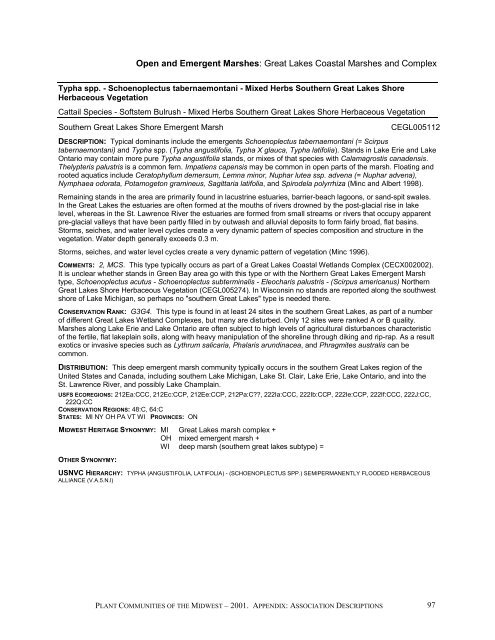Ohio subset of Plant Communities of the Midwest ... - NatureServe
Ohio subset of Plant Communities of the Midwest ... - NatureServe
Ohio subset of Plant Communities of the Midwest ... - NatureServe
Create successful ePaper yourself
Turn your PDF publications into a flip-book with our unique Google optimized e-Paper software.
Open and Emergent Marshes: Great Lakes Coastal Marshes and Complex<br />
Typha spp. - Schoenoplectus tabernaemontani - Mixed Herbs Sou<strong>the</strong>rn Great Lakes Shore<br />
Herbaceous Vegetation<br />
Cattail Species - S<strong>of</strong>tstem Bulrush - Mixed Herbs Sou<strong>the</strong>rn Great Lakes Shore Herbaceous Vegetation<br />
Sou<strong>the</strong>rn Great Lakes Shore Emergent Marsh<br />
CEGL005112<br />
DESCRIPTION: Typical dominants include <strong>the</strong> emergents Schoenoplectus tabernaemontani (= Scirpus<br />
tabernaemontani) and Typha spp. (Typha angustifolia, Typha X glauca, Typha latifolia). Stands in Lake Erie and Lake<br />
Ontario may contain more pure Typha angustifolia stands, or mixes <strong>of</strong> that species with Calamagrostis canadensis.<br />
Thelypteris palustris is a common fern. Impatiens capensis may be common in open parts <strong>of</strong> <strong>the</strong> marsh. Floating and<br />
rooted aquatics include Ceratophyllum demersum, Lemna minor, Nuphar lutea ssp. advena (= Nuphar advena),<br />
Nymphaea odorata, Potamogeton gramineus, Sagittaria latifolia, and Spirodela polyrrhiza (Minc and Albert 1998).<br />
Remaining stands in <strong>the</strong> area are primarily found in lacustrine estuaries, barrier-beach lagoons, or sand-spit swales.<br />
In <strong>the</strong> Great Lakes <strong>the</strong> estuaries are <strong>of</strong>ten formed at <strong>the</strong> mouths <strong>of</strong> rivers drowned by <strong>the</strong> post-glacial rise in lake<br />
level, whereas in <strong>the</strong> St. Lawrence River <strong>the</strong> estuaries are formed from small streams or rivers that occupy apparent<br />
pre-glacial valleys that have been partly filled in by outwash and alluvial deposits to form fairly broad, flat basins.<br />
Storms, seiches, and water level cycles create a very dynamic pattern <strong>of</strong> species composition and structure in <strong>the</strong><br />
vegetation. Water depth generally exceeds 0.3 m.<br />
Storms, seiches, and water level cycles create a very dynamic pattern <strong>of</strong> vegetation (Minc 1996).<br />
COMMENTS: 2, MCS. This type typically occurs as part <strong>of</strong> a Great Lakes Coastal Wetlands Complex (CECX002002).<br />
It is unclear whe<strong>the</strong>r stands in Green Bay area go with this type or with <strong>the</strong> Nor<strong>the</strong>rn Great Lakes Emergent Marsh<br />
type, Schoenoplectus acutus - Schoenoplectus subterminalis - Eleocharis palustris - (Scirpus americanus) Nor<strong>the</strong>rn<br />
Great Lakes Shore Herbaceous Vegetation (CEGL005274). In Wisconsin no stands are reported along <strong>the</strong> southwest<br />
shore <strong>of</strong> Lake Michigan, so perhaps no "sou<strong>the</strong>rn Great Lakes" type is needed <strong>the</strong>re.<br />
CONSERVATION RANK: G3G4. This type is found in at least 24 sites in <strong>the</strong> sou<strong>the</strong>rn Great Lakes, as part <strong>of</strong> a number<br />
<strong>of</strong> different Great Lakes Wetland Complexes, but many are disturbed. Only 12 sites were ranked A or B quality.<br />
Marshes along Lake Erie and Lake Ontario are <strong>of</strong>ten subject to high levels <strong>of</strong> agricultural disturbances characteristic<br />
<strong>of</strong> <strong>the</strong> fertile, flat lakeplain soils, along with heavy manipulation <strong>of</strong> <strong>the</strong> shoreline through diking and rip-rap. As a result<br />
exotics or invasive species such as Lythrum salicaria, Phalaris arundinacea, and Phragmites australis can be<br />
common.<br />
DISTRIBUTION: This deep emergent marsh community typically occurs in <strong>the</strong> sou<strong>the</strong>rn Great Lakes region <strong>of</strong> <strong>the</strong><br />
United States and Canada, including sou<strong>the</strong>rn Lake Michigan, Lake St. Clair, Lake Erie, Lake Ontario, and into <strong>the</strong><br />
St. Lawrence River, and possibly Lake Champlain.<br />
USFS ECOREGIONS: 212Ea:CCC, 212Ec:CCP, 212Ee:CCP, 212Pa:C, 222Ia:CCC, 222Ib:CCP, 222Ie:CCP, 222If:CCC, 222J:CC,<br />
222Q:CC<br />
CONSERVATION REGIONS: 48:C, 64:C<br />
STATES: MI NY OH PA VT WI PROVINCES: ON<br />
MIDWEST HERITAGE SYNONYMY: MI Great Lakes marsh complex +<br />
OH mixed emergent marsh +<br />
WI deep marsh (sou<strong>the</strong>rn great lakes subtype) =<br />
OTHER SYNONYMY:<br />
USNVC HIERARCHY: TYPHA (ANGUSTIFOLIA, LATIFOLIA) - (SCHOENOPLECTUS SPP.) SEMIPERMANENTLY FLOODED HERBACEOUS<br />
ALLIANCE (V.A.5.N.l)<br />
PLANT COMMUNITIES OF THE MIDWEST – 2001. APPENDIX: ASSOCIATION DESCRIPTIONS<br />
97
















